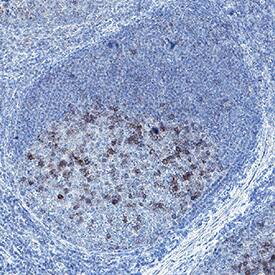Mouse Artemin Antibody
R&D Systems, part of Bio-Techne | Catalog # MAB10851

Key Product Details
Species Reactivity
Validated:
Cited:
Applications
Validated:
Cited:
Label
Antibody Source
Product Specifications
Immunogen
Ala112-Gly224
Accession # Q9Z0L2.1
Specificity
Clonality
Host
Isotype
Scientific Data Images for Mouse Artemin Antibody
Artemin in Human tonsil.
Artemin was detected in immersion fixed paraffin-embedded sections of human tonsil using Rat Anti-Mouse Artemin Monoclonal Antibody (Catalog # MAB10851) at 3 µg/mL for 1 hour at room temperature followed by incubation with the Anti-Rabbit IgG VisUCyte™ HRP Polymer Antibody (VC003). Before incubation with the primary antibody, tissue was subjected to heat-induced epitope retrieval using Antigen Retrieval Reagent-Basic (CTS013). Tissue was stained using DAB (brown) and counterstained with hematoxylin (blue). Specific staining was localized to lymphocytes in germinal centers. Staining was performed using our protocol for IHC Staining with VisUCyte HRP Polymer Detection Reagents.Applications for Mouse Artemin Antibody
Immunohistochemistry
Sample: Immersion fixed paraffin-embedded sections of human tonsil
Western Blot
Sample: Recombinant Mouse Artemin (Catalog # 1085-AR)
under non-reducing conditions only
Reviewed Applications
Read 2 reviews rated 5 using MAB10851 in the following applications:
Formulation, Preparation, and Storage
Purification
Reconstitution
Formulation
Shipping
Stability & Storage
- 12 months from date of receipt, -20 to -70 °C as supplied.
- 1 month, 2 to 8 °C under sterile conditions after reconstitution.
- 6 months, -20 to -70 °C under sterile conditions after reconstitution.
Background: Artemin
Artemin is a member of the Glia Cell-Derived Neurotrophic factor (GDNF) family ligands, which include GDNF, Persephin, Artemin, and Neurturin. GDNF family ligands are distant members of the Transforming Growth Factor beta (TGF-beta) superfamily (1‑4). Similar to other TGF-beta family proteins, Artemin is synthesized as a large precursor protein that is cleaved at the dibasic cleavage site (RXXR) to release the carboxy-terminal domain. The carboxy-terminal domain of Artemin contains the characteristic seven conserved cysteine residues necessary for the formation of the cysteine-knot and the single interchain disulfide bond. Biologically active Artemin is a disulfide-linked homodimer of the carboxy-terminal 113 amino acid residues. Mature mouse Artemin shares 88.5% amino acid sequence similarity with human Artemin. Mature Artemin also shares approximately 40% amino acid sequence identity with the other three members of the GDNF family ligands (5). Bioactivities of all GDNF family ligands are mediated through a receptor complex composed of a high affinity ligand binding component (GFR alpha1‑GFR alpha4) and a common signaling component, cRET (receptor tyrosine kinase) (5‑8). Artemin prefers to bind to GFR alpha3 and activites the GFR alpha3‑RET. However, in the presence of RET, it can bind to GFR alpha1 as well (4, 5, 9). Artemin has been shown to promote the survival and growth of various peripheral and central neurons, including sympathetic and dopaminergic neurons. It may also play an important role in the development of sympathetic neurons and several organs (5, 10, 11).
References
- Lin, L-F.H. et al. (1993) Science 260:1130.
- Milbrandt, J. et al. (1998) Neuron 20:245.
- Kotzbauer, P.T. et al. (1996) Nature 384:467.
- Baloh, R.H. et al. (1998) Neuron 21:1291.
- Takahashi, M. (2001) Cytokine and Growth Factor Reviews 12:361.
- Baloh, R.H. et al. (1997) Neuron 18:793.
- Jing, S. et al. (1996) Cell 85:1113.
- Jing, S. et al. (1997) J Biol Chem 272:33111.
- Nishino, J. et al. (1999) Neuron 23:725.
- Enomoto, H. et al. (2001) Development 128:3963.
- Andres, R. et al. (2001) Development 128:3685.
Alternate Names
Gene Symbol
UniProt
Additional Artemin Products
Product Documents for Mouse Artemin Antibody
Product Specific Notices for Mouse Artemin Antibody
For research use only
